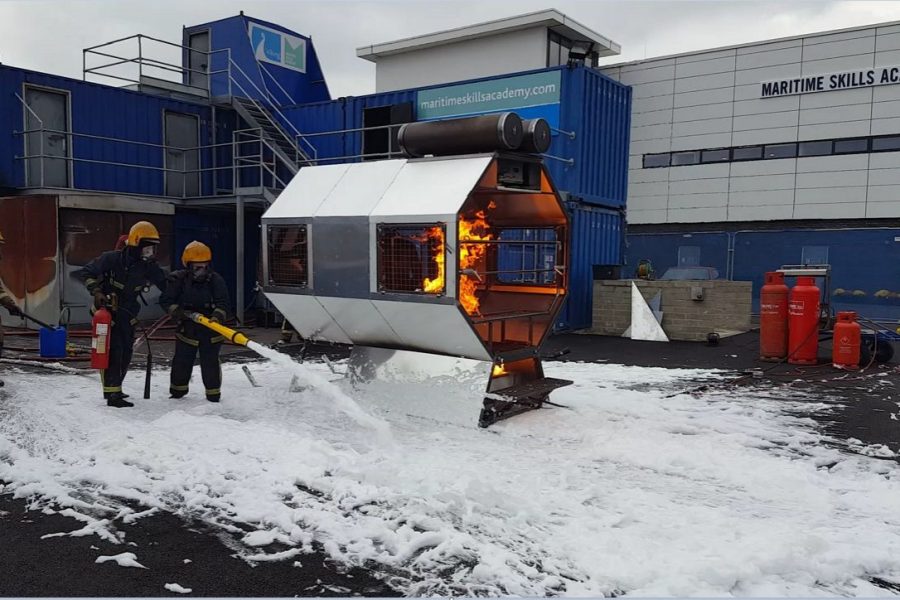Helicopter Firefighting – The Essence of Helideck Safety
Helicopter firefighting is a specialist subject. It is very different to ship compartmental firefighting taught during STCW training and requires very different firefighting techniques. Helicopter firefighting has to be practiced physically and cannot be taught solely using PowerPoint. This is acknowledged by the MCA in its Large Yacht Helideck Safety Training Syllabus, which requires live helicopter fires to be extinguished. The MCA also demands that crew required to hold MCA Helicopter Landing Officer (HLO) or Helideck Assistant (HDA) qualifications, must have undertaken an approved helicopter firefighting course before they can perform their helideck duties on board.
A frequent statement heard in reply to being asked about helideck team responses to helideck fires is, ‘If there’s a helicopter fire, we’ll just initiate the helideck pop-up sprays’. These sprays appear to be seen as the initial response by many but they are not intended to be such. Helideck pop-up sprays are not the panacea for all helideck fires and should actually be the last resort, to be used when all other options have failed. Firstly, not all helidecks have pop-up sprays, so cannot be relied upon as a standard response. Secondly, some helicopter fires will be of a minor nature and covering the whole helicopter and helideck in spray would not be an appropriate response. But the main reason is that initiation of the sprays and covering the helicopter and helideck in foam will generally just paint everything white. On their own, pop-up sprays will not create the survivable conditions required to allow for the evacuation or extraction of trapped personnel. That is the job of the trained and qualified helideck firefighting team.
A common question asked by superyacht Captains is, “Do we really need 2 helideck firefighters when we do heli ops?” There are 2 answers to this question but they are not ‘yes’ and ‘no’. One is the regulatory answer and the other is the operational answer…and both are an unequivocal ‘yes’!
Looking at the regulations first, it is not just at the flag state level which requires fire cover during helicopter operations conducted on board aviation-capable vessels. It is more fundamental than that. The SOLAS Convention, Part G, Regulation 18 refers to additional measures to enhance fire safety for ships fitted with special facilities for helicopters. Section 8 of the regulation stipulates the need for at least 2 persons, trained for rescue and firefighting, to be available immediately at all times when helicopter operations are expected. This means they should be dressed with BA (off air) and ready to respond immediately to any helideck incident which may occur.
The operational answer is that whatever types of helicopter operations are performed on board, there is a risk of something going wrong. However unlikely that risk may be, whether the yacht undertakes occasional ‘touch & go’ guest transfers or regular sling loading of quad bikes ashore, when on or around the helideck, operating a helicopter poses a hazard. Should the aircraft suffer a catastrophic failure during take-off or landing, or if a skid should impact with the deck, causing dynamic rollover, any resulting crash on deck is likely to happen extremely quickly. It can take literally seconds to go from normal operations on a sunny day with a flat calm sea, to a helicopter flailing itself to bits whilst upside down on the helideck with leaking atomised hydraulic fluid igniting to create an intense fireball, whilst personnel are trapped inside the helicopter. The helideck firefighters will be required to respond immediately to any situation they may face as a result of any such Crash, Fire & Rescue (CFR) incident, in order to bring about a successful outcome.
But what would a successful outcome be? What would be deemed successful helicopter firefighting? Would it be putting the fire out? Would it be controlling the flames to prevent any escalation of the fire? Would it be preventing secondary fires from igniting? These are all valid reasons but the main aim of helideck firefighting is to create the survivable conditions for the evacuation or extraction of personnel from the helicopter. In the case of a superyacht, the helicopter is likely to be carrying the owner and/or their family, whose survival is key to the existence of the whole vessel. Every CFR incident will be different and only by understanding fully the correct techniques to fight helicopter fires appropriately and then practicing them in a controlled environment, can helideck personnel maximise the probability of a successful outcome from any CFR incident.
In order to deal with the myriad scenarios, it stands to reason that the helideck crew should be trained specifically in the correct practical techniques for successful helicopter firefighting as part of their Emergency Operating Procedures (EOPs). That is exactly what is required by the MCA for helideck personnel required to hold a valid MCA-accredited HLO or HDA certificate. Without an approved helideck firefighting qualification, such helideck crew members are not qualified fully to carry out their helideck role on board. But what are the MCA-approved standards for helicopter firefighting?
There are 2 standards recognised by the MCA for helideck firefighting. The first one is the Offshore Petroleum Industry Training Organisation (OPITO) standard. This training standard is designed for offshore oil & gas rig helidecks and is generally not regarded as being particularly suited to superyachts. The alternative standard is the one developed by the MCA itself as part of its Large Yacht Helideck Safety Training Syllabus, called MCA Large Yacht Helideck Fire Fighting. Designed to complement the other courses in the syllabus, this course is designed for helideck firefighting on superyachts and covers the main types of fire which may be encountered as a result of a helicopter incident on board, passenger extractions and crash on deck scenarios. The course requires both theory and practical firefighting elements and therefore cannot be delivered on board a vessel in much the same way that STCW Basic and Advanced Firefighting courses are not carried out on board.
In response to this burgeoning requirement for an industry-recognised superyacht helideck firefighting qualification, MAST (Maritime Aviation Support & Training), also trading as Superyacht Aviation, has teamed up with the Maritime Skills Academy (MSA) who are part of the Viking Group of companies in Dover. Together, MAST and the MSA are joint providers of the first MCA-approved Helideck Fire Fighting course. Delivered over 1 day in Dover, the course combines theory and live fire practical sessions using a bespoke Helicopter Firefighting Training Unit (HFTU). Covering a multitude of CFR scenarios, course delegates will be trained to be competent to tackle any helideck emergency situation they may face on board their vessels.
The Helideck Fire Fighting course can be delivered separately or as part of the full suite of MCA-approved helideck courses. MAST is the only provider of all 4 MCA Large Yacht Helideck Safety Training courses. The other 3 courses in the MCA’s syllabus, which MAST can deliver peripatetically, on board at the client’s convenience, are: Helideck Procedures & Emergency Response (effectively an HDA course); Helicopter Landing Officer; and Helicopter Refuelling. Delegates undertaking any helideck training in Dover, however, can also make use of the MSA’s other maritime training facilities to complete any of the STCW courses taught in the new environmental survival complex and at Dover quayside. The MSA is the industry’s one-stop location for all maritime and helideck safety training.
So, for any HLOs and HDAs which are required to be MCA-accredited, it is recommended that management companies, Captains and individuals check that they are fully qualified and competent to perform their helideck role on board. Even for HLOs and HDAs which are not required to be MCA-accredited for their helideck roles, the specialist nature of helideck and helicopter firefighting and how quickly personnel need to respond to any CFR incidents, suggests that it is worth all helideck crew being trained to the recognised superyacht industry standard. The real question for owners, management companies and Captains is, ‘Can we afford for our helideck crew not to be qualified and competent in industry-recognised, specialist helideck firefighting?’
If you would like to discuss any aspects of the MCA’s Large Yacht Helideck Safety Training Syllabus we deliver, please contact Jonathan at: jonathan@mastconsultancy.com. To book places, please contact Tracy at: shortcourses@vikingrecruitment.com.


